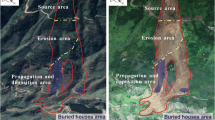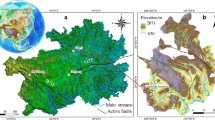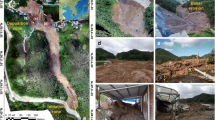Abstract
On July 23, 2019, a large-scale landslide occurred in Jichang town, Shuicheng County, Liupanshui City, Guizhou Province in China. The landslide, which moved along two gullies, resulted in strong punching-shear, induced scarping on vegetation and large destruction of houses, and finally formed a deposit with a volume of 2 × 106 m3. This research aims to understand the effect of topography on landslide kinematics. To achieve this aim, a detailed field investigation was first carried out with an unmanned aerial vehicle (UAV) aerial photography survey, resident interviews, and field sampling. The rainfall analysis indicates the effective rainfall within 7 days before landslides was 70.14 mm which exceeded the rainfall threshold of 54.3 mm in this region, which finally triggered the landslide. Traditional soil mechanic tests were then performed to identify the soil properties of the source material. Combined with numerical simulation using the nonlinear shallow water equation, the whole process of landslides was divided into four stages: instability stage, acceleration stage, transformation stage, and impact and accumulation stage. The simulations results show the landslide block slid with a low velocity of 8 m/s for about 100 m. Then, Froude number of landslide increases from 2 to 3 when passing the high and steep terrain, indicating that landslide change to inertial dominated with potential same Froude behavior of classic debris flow. The rupture mass slid with the peak velocity of 23 m/s and diverged in two gullies and ran out for about 600 m. The maximum velocity is 23 m/s in east gully while only 15 m/s in west gully. Compared with deep and incised valleys in the west, shallow and straight valley in the east decreases the deposit depth and further increases the velocity of landslide material with increased runout distance. This research may provide a fast flow path of back analyzing geo-hazards on complex terrain and serve as a basis for future research on long runout landslides.

















Similar content being viewed by others
References
Armanini A, Larcher M, Odorizzi M (2011) Dynamic impact of a debris flow front against a vertical wall. In: Proceedings of 5th international conference on debris-flow hazards “mitigation, mechanics, prediction and assessment”, Padua, Italy
ASTM (2013) Standard practices for obtaining intact block (cubical and cylindrical) samples of soils. Annual Book of ASTM Standards, 1–13
ASTM D2487-17 (2017) Standard Practice for Classification of Soils for Engineering Purposes (Unified Soil Classification System), ASTM International, West Conshohocken, PA
Bruce JP, Clark RH (1966) Index-introduction to hydrometeorology. Introduction to Hydrometeorology 13(2):1–4
Cao X, Zhou Q, Liu C (2015) Distribution pattern of coseismic landslides triggered by the 2014 ludian, Yunnan, China Mw6.1 earthquake: special controlling conditions of local topography. Landslides 12(6):1159–1168
Chen XZ, Cui YF (2017) The formation of the Wulipo landslide and the resulting debris flow in Dujiangyan city, China. J Mt Sci 14:1100–1112
Choi CE, Au-Yeung SCH, Ng CWW, Song D (2015) Flume investigation of landslide granular debris and water runup mechanisms. Géotech Lett 5(1):28–32
Cui P (2014) Progress and prospects in research on mountain hazards in China. Prog Geogr 33:145–152
Cui P, Guo XJ, Zhuang JQ (2014) Determination of the runoff threshold for triggering debris flows in the area affected by the Wenchuan earthquake. Nat Hazards Earth Syst Sci Discuss 2:4659–4684
Cui YF, Zhou XJ, Guo CX (2017) Experimental study on the moving characteristics of fine grains in wide grading unconsolidated soil under heavy rainfall. J Mt Sci 14(3):417–431
Cui Y, Choi CE, Liu LHD, Ng CWW (2018) Effects of particle size of mono-disperse granular flows impacting a rigid barrier. Nat Hazards 91(3):1179–1201
Cui Y, Cheng D, Choi CE, Jin W, Lei Y, Kargel JS (2019a) The cost of rapid and haphazard urbanization: lessons learned from the Freetown landslide disaster. Landslides 16:1167–1176
Cui Y, Jiang Y, Guo C (2019b) Investigation of the initiation of shallow failure in widely graded loose soil slopes considering interstitial flow and surface runoff. Landslides 16(4):815–828
Daraei A, Zare S (2018) Effect of water content variations on critical and failure strains of rock. KSCE J Civ Eng 22:3331
Dastjerdi MHT, Habibagahi G, Nikooee E (2014) Effect of confining stress on soil water retention curve and its impact on the shear strength of unsaturated soils. Vadose Zone Journal 13:1–11
Fan X, Scaringi G, Korup O, West AJ, Westen CJ, Tanyas H, Hovius N, Hales TC, Jibson RW, Allstadt KE, Zhang L, Evans SG, Xu C, Li G, Pei X, Xu Q, Huang R (2019) Earthquake-induced chains of geologic hazards: patterns, mechanisms, and impacts. Rev Geophys 57(2):421–503
Fan XY, Leng XY, Duan XD (2015) Influence of topographical factors on movement distances of toe-type and turning-type landslides triggered by earthquake. Rock Soil Mech 36(5):1380–1388 (in chinese)
Guo CX, Zhou JW, Cui P, Hao MH, Xu FG (2014) A theoretical model for the initiation of debris flow in unconsolidated soil under hydrodynamic conditions. Nat Hazards Earth Syst Sci Discuss 2:4487–4524
Guo J, Li T, Li P, Lin X, Shen W (2018) A numerical model for simulation of flowslide on curved. J Eng Geol 26:319–324 (In Chinese)
Hu S, Qiu H, Pei Y, Cui Y, Xie W, Wang X (2019) Digital terrain analysis of a landslide on the loess tableland using high-resolution topography data. Landslides 16(3):617–632
Igwe O, Wang F, Sassa K, Fukuoka H (2013) The laboratory evidence of phase transformation from landslide to debris flow. Geosci J 18:31–44
Iverson RM, Reid ME, LaHusen RG (1997) Debris-flow mobilization from landslides. Annu Rev Earth Planet Sci 25(1):85–138
Iverson RM (1997) The physics of debris flows. Rev Geophys 35:245–296
Iverson RM, Reid ME, Logan M, LaHusen RG, Godt JW, Griswold JP (2010) Positive feedback and momentum growth during debris-flow entrainment of wet bed sediment. Nat Geosci 4:116–121
Lu N, Godt JW, Wu DT (2010) A closed-form equation for effective stress in unsaturated soil. Water Resour Res 46:567–573
Nian TK, Feng ZK, Yu PC, Wu HJ (2011) Shear test on mixed slide-zone soils of landslide under different water content. Adv Mater Res 301-303:6
Nuth M, Laloui L (2010) Effective stress concept in unsaturated soils: clarification and validation of a unified framework. Int J Numer Anal Methods Geomech 32:771–801
Ouyang CJ, Zhao W, He SM, Wang DP, Zhou S, An HC, Wang ZW, Cheng DX (2017) Numerical modeling and dynamic analysis of the 2017 xinmo landslide in Maoxian County, China. J Mt Sci 14:1701–1711
Ouyang CJ, Zhou K, Xu Q, Yin J, Peng D, Wang D, Li W (2016) Dynamic analysis and numerical modeling of the 2015 catastrophic landslide of the construction waste landfill at Guangming, Shenzhen, China. Landslides 14:705–718
Peng J, Fan Z, Wu D, Zhuang J, Dai F, Chen W, Zhao C (2015) Heavy rainfall triggered loess–mudstone landslide and subsequent debris flow in Tianshui, China. Eng Geol 186:79–90
Qu NN, Yao L, Zhu DY, Li JB (2016) Study of three dimentional spatial shapes and determination of intermediate-acid intrusive rock in middle and East Guizhou. Guizhou Geology 33(02):126–131 (in Chinese)
Rahimi A, Rahardjo H, Leong EC (2011) Effect of antecedent rainfall patterns on rainfall-induced slope failure. J Geotech Geoenviron Eng 137:483–491
Sassa K, Wang G, Fukuoka H, Wang F, Ochiai T, Sugiyama M, Sekiguchi T (2004a) Landslide risk evaluation and hazard zoning for rapid and long-travel landslides in urban development areas. Landslides 1:221–235
Sassa K, Fukuoka H, Wang G, Ishikawa N (2004b) Undrained dynamic-loading ring-shear apparatus and its application to landslide dynamics. Landslides 1:7–19
Sassa K, Takagawa T (2018) Liquefied gravity flow-induced tsunami: first evidence and comparison from the 2018 Indonesia Sulawesi earthquake and tsunami disasters. Landslides 16:195–200
Schulz W, Smith J, Wang G, Yao J, Roering J (2018) Clayey landslide initiation and acceleration strongly modulated by soil swelling. Geophys Res Lett 45(4):1888–1896
Shen W, Li T, Li P, Guo J (2018) A modified finite difference model for the modeling of flowslides. Landslides 15:1577–1593
Shen W, Li T, Li P, Shen Y, Lei Y, Guo J (2019) The influence of the bed entrainment-induced rheology and topography changes on the propagation of flow-like landslides: a numerical investigation. Bull Eng Geol Environ 78(7):4771–4785
Shi XQ, Xiao TG, Fang YJ, Huang J (2016) Study of precipitation concentration threshold at the different geological disaster affected zone in Southwest China. Plateau Mountain Meteorol Res 36(01):63–67 (in Chinese)
Si JF, Yin HF, Li FD, Zhang BJ, Li MY (2012) Characteristics and causes of geological hazards and the preventive measures in Shuicheng, Guizhou, China. Chin J Geol Hazard Control 23(1):111–115 (in Chinese)
Suradi M, Fourie A (2014) The effect of rainfall patterns on the mechanisms of shallow slope failure. Aceh Int J Sci Technol 3:1–18
Takahashi T (2014) Debris flow: mechanics, prediction, and countermeasures, 2nd edn. CRC press, London
Tang HM, Liao PW, Wang LF, Chen HK (2013) Experimental study on gravel soils of matrix suction. Appl Mech Mater 275-277:310–315
Tohari A (2018) Study of rainfall-induced landslide: a review. IOP Conference Series: Earth and Environmental Science 118, 012036
Wang J, Ward SN, Xiao L (2019) Tsunami squares modeling of landslide generated impulsive waves and its application to the 1792 Unzen-Mayuyama mega-slide in Japan. Eng Geol 256:121–137
Xing A, Yuan X, Xu Q, Zhao Q, Cheng Q (2016) Characteristics and numerical runout modelling of a catastrophic rock avalanche triggered by the wenchuan earthquake in the Wenjia valley, Mianzhu, Sichuan, China. Landslides 14(1):1–16
Xu C, Qian HT, Jiang WL, Ren JJ, Ma SY, Li Q, Du Y (2019) Emergency report of the landslide of the Dinggou formation in Pingdi Village, Jichang Town, Jiudian County, Guizhou Province. http://www.eqicd.cn/Index/show/catid/208/id/4649.html
Xu L, Meng X, Xu X (2014) Natural hazard chain research in China: a review. Nat Hazards 70(2):1631–1659
Yin Y, Cheng Y, Liang J, Wang W (2016) Heavy-rainfall-induced catastrophic rockslide-debris flow at Sanxicun, Dujiangyan, after the Wenchuan Ms 8.0 earthquake. Landslides 13(1):9–23
Zhang J, Huang HW, Zhang LM, Zhu HH, Shi B (2014) Probabilistic prediction of rainfall-induced slope failure using a mechanics-based model. Eng Geol 168:129–140
Zhang Z, Tao W, Wu S, Tang H, Liang C (2018) Dynamics characteristic of red clay in a deep-seated landslide, Northwest China: An experiment study. Eng Geol 239:254–268
Zhao WF, Li L, Xiao YH (2014) Experimental research of matrix suction of the unsaturated red clay. Adv Mater Res 919-921:835–838
Zhou GGD, Cui P, Chen HY, Zhu XH, Tang JB, Sun QC (2013a) Experimental study on cascading landslide dam failures by upstream flows. Landslides 10(5):633–643
Zhou JW, Peng C, Yang XG (2013b) Dynamic process analysis for the initiation and movement of the Donghekou landslide-debris flow triggered by the Wenchuan earthquake. J Asian Earth Sci 76:70–84
Funding
The study here is funded by the National Natural Science Foundation of China (41790434) and the Chinese Academy of Sciences (XDA23090401), as well as the Major International (Regional) Joint Research Project (No. 41520104002), the Key Research Program of Frontier Sciences, CAS (QYZDY-SSW-DQC006), and the National Key R&D program of China (No. 2017YFC1501302).
Author information
Authors and Affiliations
Corresponding author
Rights and permissions
About this article
Cite this article
Guo, J., Yi, S., Yin, Y. et al. The effect of topography on landslide kinematics: a case study of the Jichang town landslide in Guizhou, China. Landslides 17, 959–973 (2020). https://doi.org/10.1007/s10346-019-01339-9
Received:
Accepted:
Published:
Issue Date:
DOI: https://doi.org/10.1007/s10346-019-01339-9




